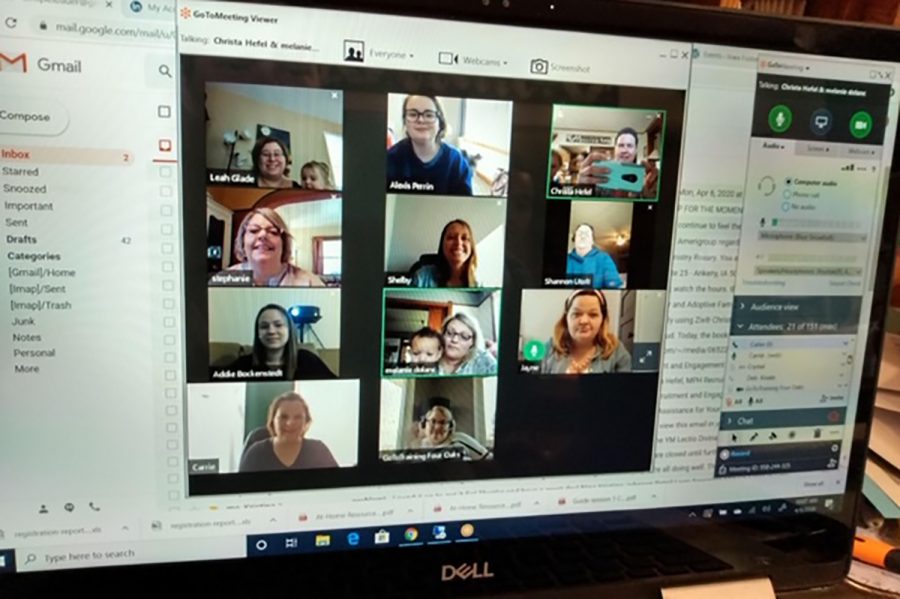Social workers, child-welfare services fight for child safety and family support during COVID-19
Direct and indirect social work is traditionally an in-person job. Amid COVID-19 mitigation measures like social distancing, however, the Iowa Department of Human Services and similar family and child welfare services, are critically readjusting how they conduct social work to ensure the wellbeing of the community.
April 13, 2020
Social workers, family needs, and foster care are among the essential services that have not been put on pause amid the novel-coronavirus pandemic. In Iowa, while some non-urgent matters can be done via conference calls, new child abuse or family crisis cases must be conducted in person, and are complicated by K-12 schools being closed for the month.
“We have been impacted on basically every front in terms of the work we do,” said Janee Harvey, division administrator of adult, children, and family services at the Iowa Department of Human Services.
Harvey said that self-isolation and social-distancing recommendations have made the fundamental methods social workers use to conduct their work feel “really unsafe.”
“… We absolutely think social work is fundamentally an in-person type of a service. Social workers go into homes they go and meet with collateral contacts — they’re physically in-person observing children, they’re providing emotional support to parents,” Harvey said. “In circumstances where kids are actually in foster care and not living with their parents, one of our primary strategies or one of our commitments is ensuring that parents have frequent and safe, what we call ‘family interactions,’ so that’s parenting time.”
Harvey said having to rethink this approach to their work has been necessary to ensure that social workers are not jeopardizing child safety, because that safety and support for parents is the primary goal of social work. According to the Iowa Department of Public Health, there were 34,328 assessments for child abuse or neglect in Iowa in calendar 2018.
The Iowa Department of Human Services implemented pre-health screenings (mandated for staff) issued guidance, and provided hand sanitizer for members in its effort to maintain the health and safety of staff and clients, Harvey said.
For ongoing cases that are not of urgent or pressing concern, some contact has temporarily been moved to an electronic format, Harvey said, though in-person contacts remain critical for new cases.
“We really cannot walk away from the fact that somebody has been concerned enough they’ve reported that a child is being abused or neglected,” Harvey said. “You cannot do that work through video conferencing.”
Closed schools also have the potential to disrupt child welfare, Harvey said, because teachers are primary reporters of abuse and neglect.
“What we see … is we have kids who are experiencing a tremendous amount of loss right now, they are suddenly not going back to their teachers, if they have food insecurity, they may not be able to count on regular food,” Harvey said.

RELATED: Final semesters derailed: Iowa City’s High School seniors prepare for life after high school
Harvey said the Department of Human Services has been working closely with the Iowa Department of Education and state school systems. One such collaborative effort encourages teachers to make “comfort calls,” and check up on students.
“All these kids who are suddenly not in front of us, they are all cared for and loved and we need to make sure that as communities, we recognize those opportunities to still transmit those messages that those kids are loved and cared for, even in this stressful time,” Harvey said.
Matt Highland, public information officer for the Iowa Department of Human Services, said that communities, neighbors, essentially everyone needs to step up while schools aren’t in session.
“ … People really need to be paying attention now more than ever,” Highland said. “We know with added economic hardship and stress that families may be experiencing, there’s a risk for an increase in abuse and we just want to put the call out that everybody should be paying attention — this is something we’re really focused on.”
Highland added the Iowa Department of Human Services, which has offices in each of the state’s 99 counties, is also working to provide quality child-care services for the essential workforce as a response to the pandemic.
Shelby Meythaler, supervisor in the foster and adoptive family connections program at the Four Oaks in Cedar Rapids — which recruits, trains, and supports foster and adoptive families in Iowa and is contracted by the Department of Human Services — said conducting face-to-face visits with families has been the main challenge presented by the pandemic.
To help ensure as much social distancing as possible, Meythaler said the staff at Four Oaks has worked primarily from home and set up a calendar to rotate who comes in on certain days to mitigate exposure.
Meythaler said pre-screening questions now precede any face-to-face visits, and the alternative is video-conference calls for families that indicate potential exposure or symptoms.
“Just so obviously [foster families] can still continue to learn and grow and at least have information on how to best care for these kids who experience trauma and are coming through the child welfare system,” Meytahler said.
She added that COVID-19 affected foster-family training and recruitment events in the community, and video conference calls replaced training as well.
Lisa D’Aunno, director of training at the National Resource Center for Family Centered Practice at the University of Iowa School of Social Work, said Iowa has one of the tightest timelines for parents making substantial progress toward reunifying with their children.
“We know — our research tells us that parent child visitation is the most significant predictor of reunification,” D’Aunno said.
Amid the pandemic, both the Iowa Supreme Court and Department of Human Services have made it clear that family reunification comes first and foremost, D’Aunno said, and parent-child visits remain a priority.
“We can’t let up, because if we don’t maintain visits those families are at risk of never getting back together,” D’Aunno said.
D’Aunno said that, in many ways, direct-service social workers are first responders.
“I think our social workers are really brave,” D’Aunno said. “They put themselves out there. Home visiting isn’t easy under normal circumstances — they have to worry about their physical safety and maybe in domestic violence situations and of course in removing a child from the home is a really scary time too. So, they’re pretty tough folk, but this adds another challenge.”
D’Aunno added that, although many indirect-service social workers may not be considered an essential service, they are continuing their work anyway.
“You’ve got social workers in brain-injury houses, mental-health group homes, group homes for developmentally disabled folks,” D’aunno said. “Those social workers are on the job and of course they’re doing what mitigation they can, but they’re on the front lines, [and] they don’t always have PPE.”



